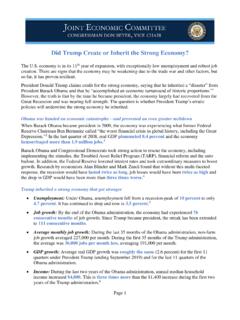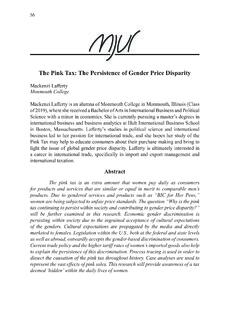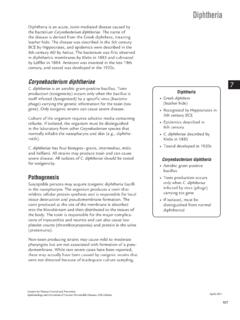Transcription of The Pink Tax How Gender-Based Pricing Hurts Women’s …
1 December 2016 The pink Tax How Gender-Based Pricing Hurts Women s Buying Power Much has been written about women as wage-earners, particularly the fact that they typically earn less than men. In 2015, a woman with median earnings working full time, year-round earned only 80 percent of what her male counterpart This 20-percent difference is widely known as the gender pay gap. For a typical female worker, the pay gap adds up to nearly $10,500 over the course of a year and roughly $500,000 over a This contributes to higher poverty rates among women. Research has shown that if women were paid the same as comparable men, the poverty rate among working women would be cut in However, it is less well known that women also are disadvantaged as consumers frequently paying substantially more than men for similar goods and services.
2 Common products and services marketed to women, ranging from razors and soaps to dry cleaning, often cost more than similar products marketed to men. Manufacturers and retailers may claim that the price difference is due to higher costs for producing women s products or providing services for women, but there is a great deal of evidence that there are significant price differences for practically identical products. In some cases, the only difference is the color. This markup has become known as the pink tax. Despite Challenges, Women s Earning Power Is Greater than Ever Women s participation in the paid workforce has increased dramatically since the Equal Pay Act and Civil Rights Act were enacted more than 50 years ago. At that time, fewer than half of prime-age women (ages 25 to 54) were in the labor force, and only one in three jobs was held by a woman.
3 Today, nearly three-quarters of all prime-age women are in the workforce and women hold about half of all The sea change in women s labor force participation, as well as increases in their educational attainment, has dramatically boosted women s collective earnings. Between 1967, the first year for which data are available, and 2015, the number of women with earnings grew from 34 million to 77 million. After adjusting for inflation, their average earnings increased from $17,250 (in 2015 Prepared by the Democratic staff of the Joint Economic Committee Page 2 dollars) to $39,400. The result was a fivefold increase in women s combined earnings, from roughly $593 billion in 1967 to more than $3 trillion in 2015 (see Figure 1).5 This explosion in earning power, coupled with rising household expenses, has meant that families have come to depend on women s incomes to make ends meet.
4 In the typical (median) household with a mother working outside the home, women contribute nearly 40 percent of their family s total Almost 40 percent of married women are their family s primary wage And one in three (34 percent) families with a mother working outside the home depend solely on the mother s Women now have control over financial decisions in many households. Marketing research suggests that they make 85 percent of all consumer purchases in the United States. Their share of food purchases is even higher. Three in four women report that they are their home s primary The pink Tax : A Markup on Goods and Services Marketed to Women Even with this bolstered financial power, women face an additional obstacle as consumers. They not only earn less than men, on average, but they also often pay more for purchases or get less for what they spend.
5 This markup on goods and services marketed to women has become known as the pink tax. Examples of Gender-Based price disparities for goods and services have been documented throughout the economy. This phenomenon may not constitute intentional gender discrimination. Yet the frequency with which female consumers find themselves paying higher prices for gender-specific goods and services effectively becomes a tax on being a woman. Consumer Goods Everyday products marketed to women often come with a higher price tag when compared to nearly identical versions marketed to men. Some of the most widely cited examples include higher prices for pink razors and pastel-colored pens. Even toys marketed to girls are also priced higher. For example, a pink Radio Flyer scooter was selling for double the price of the comparable red scooter on a well-known big box retailer s Prepared by the Democratic staff of the Joint Economic Committee Page 3 The pink tax applies to products across a range of categories, including children s clothing, toys and games, and personal care products.
6 The size of the markup varies widely, and in some cases the price for men s products is higher. For example, the New York City Department of Consumer Affairs (NYCDCA) examined nearly 400 pairs of products for sale by New York City retailers and found that women s products were more than twice as likely to be priced higher than men s products. Specifically, 42 percent of the time women s products had a higher price tag, whereas men s products had a higher price tag 18 percent of the time. The prices for women s and men s products were roughly equal 40 percent of time (see Figure 2).11 Across industry categories, women s products were consistently priced higher, according to the NYCDCA report. Overall, women s products were priced an average of 7 percent higher than substantially similar men s The difference in average prices was smallest for children s clothing (4 percent), and largest for personal care products such as deodorants, body wash and razors (13 percent) (see Figure 3).
7 13 Products in the senior/home health care category were priced 8 percent higher. They included items such as supports and braces, canes and adult diapers. The additional cost to senior women is particularly troubling due to the fact that the typical woman aged 65 or older has significantly less income than the typical man of the same age. Women in this age group face a 44-percent gap in income compared to similarly aged men, and they are significantly more likely to live in poverty according to a JEC report released earlier this Men s and women s products are rarely identical, which makes precise comparisons difficult. However, multiple surveys Prepared by the Democratic staff of the Joint Economic Committee Page 4 comparing common consumer goods showed similar findings.
8 For example, Consumer Reports found that in comparing common drugstore purchases such as shaving cream, deodorant and body wash, products directed at women through packaging, description or name might cost up to 50 percent more than similar products for men. 15 A 2011 study by researchers at the University of Central Florida (UCF) also concluded that women pay more per ounce for certain personal care products, including A survey of prices for products in various categories at large online retailers revealed several examples of dramatic price BIC s For Her pens cost double the equivalent gender-neutral pack. A pink wireless mouse by Microsoft was priced 39 percent higher than the identical model in blue. A 12-pack of women s Schick s Slim Twin sensitive disposable razors cost 51 percent more than a 12-pack of men s Slim Twin sensitive disposable razors.
9 The price on women s Narciso Rodriguez Eau de Toilette spray was 20 percent higher than the men s version. And the pink and purple fairy version of simple wooden train set with a figure-eight track came with an 11-percent mark up over the nearly identical version in primary colors. Services Women not only pay more for products; they often pay more for services. A telling example is the market for personal care services, including dry cleaning and haircuts. With these services, prices are typically higher for women, such as laundering a women s button-down shirt, compared with a men s button-down shirt. The 2011 study found that of the 100 hair salons surveyed, 85 charged Prepared by the Democratic staff of the Joint Economic Committee Page 5 more for a basic women s haircut than a basic men s haircut.
10 The average price paid by women was 54 percent higher than the average price paid by men. That study also found significant price differences for drying cleaning dress shirts, with women s shirts costing on average $ , or 92 percent, more than men s shirts. The study found no significant differences in the prices of laundering two-piece suits, blazers or slacks. A study by the State of California in 1994 estimated that the pink tax on services alone cost a woman roughly $1,350 over a year, the equivalent of about $2,135 Possible Explanations for the pink Tax Differences in the cost of producing goods or providing services are legitimate reasons for selling substantially similar products or services at different prices. For example, some products may face higher tariffs and materials of a specific color or scent deemed more feminine may cost more to manufacture.















